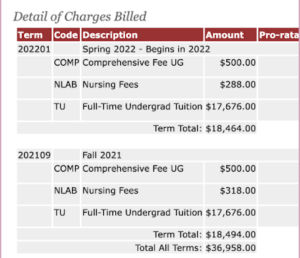By Madison Weber ’23, Staff Writer and Social Media Editor
It’s no secret that college is expensive, but nursing school has grown to cost even more than other students will likely pay. The student debt crisis has grown by 144% over the past 10 years and Fisher is no exception, with the fall 2021 full-time undergraduate tuition costing $17,676 and the spring of 2022 costing students an additional $18,464. Thankfully the majority of students at Fisher aren’t actually paying this steep price thanks to scholarships from inside and outside of the college institution.

However, nursing students have plenty of extra and mandatory costs hidden throughout the four years — from needing to buy Fisher scrubs, shoes meant solely for work or clinical, to the recommended Littman stethoscope, a blood pressure cuff, parking passes for various hospitals and the additional nursing fees that are automatically added to students’ bills. According to the nursing handbook, students may also be charged for their clinical instructors’ time in the case of missed clinical hours. Missed simulations will cost students $50 for each missed appointment.
For nursing students, their books are often bought in semester packages as well-meaning they are not afforded the luxury of being able to rent. They are often unable to buy their books elsewhere for a cheaper price as well, as they are required to buy certain codes directly from the school that comes in the book packages. For the spring 2022 semester, a J2 nursing student is paying an extra $318 to be a nursing student.
“Coming into college, I did not think that it would cost more than other majors. I had heard that nursing textbooks are expensive, but that was it,” Junior nursing student Kelsey Cahalan said. “However, there are so many little things that nursing majors have to pay for that no one thinks about. To get to and from our clinical site, we have to drive ourselves, which makes us have to pay for both the gas and parking permits.”
It is $6 a day to park at Strong Memorial Hospital... Many nursing students will end up parking there once or twice a week for the entire semester– leading to an additional cost of $90 to $180 over a semester.
Cahalan also touches on the free aspect of clinical. “When we go to clinical, we are not paid to be there. We are always told that we are ‘paid through learning.’ However, a lot of other majors when they do learning experiences are called internships and they are paid for their work.”
Clinical days are typically eight hours with a half-hour lunch included for students, but they receive no financial compensation for their time spent at the clinical site. Cahalan says that she is “fortunate that these costs do not affect my daily life as much as I know it does others.”
Assistant Professor of Nursing, Dr. Yvette Conyers, is the Diversity, Equity, and Inclusion (DEI) co-chair at Fisher; “I consider DEI a part of my heart and a part of my nursing.” Conyers said that she understands that Fisher is a business and needs to keep up with changing economic times, as the price of nursing technology continues to climb. According to Conyers, a limited number of grants for nursing and other students do exist – such as a Pell grant, HEOP, and others. But, she says, they need to be advertised. “It’s great we have this money, but do people know about it? How can real people access these funds?”
Interim undergraduate chair and assistant professor, Dr. Alyson Simpson, says that these fees come from necessary costs – and that faculty is aware. “We are very aware of how sometimes those fees start to creep up,” Simpson says that faculty can’t just add costs either. “ We have to discuss those fees at undergrad faculty meetings and they have to be voted on. We have to have a discussion about that – the benefit must outweigh the cost for students.”
She even mentions that on the agenda for the next WSON meeting is the topic of how there are too many fees for students. Simpson also mentions that many fees are for products that students will be able to use for more than one semester. “Nursing needs technology and students need to be exposed,” says Simpson on the high costs of labs and simulations.
According to both Conyers and Simpson, extra fees for nursing students are not exclusive to Fisher by any means. Simpson says that each semester students who are able to show true financial need are referred to scholarships for nursing students. “You know you’re going to have a job in nursing, thankfully– it’s an investment you’re making right now.”Conyers encourages students concerned with diversity and the price of their education to get involved with SNA on campus.




















